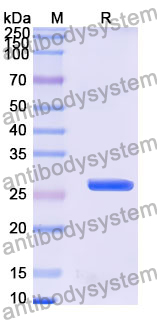Catalog No.
YHN27501
Expression system
E. coli
Species
Homo sapiens (Human)
Protein length
Arg40-Asn250
Predicted molecular weight
25.88 kDa
Nature
Recombinant
Endotoxin level
Please contact with the lab for this information.
Purity
>90% as determined by SDS-PAGE.
Accession
Q5VW38
Applications
ELISA, Immunogen, SDS-PAGE, WB, Bioactivity testing in progress
Form
Lyophilized
Storage buffer
Lyophilized from a solution in PBS pH 7.4, 0.02% NLS, 1mM EDTA, 4% Trehalose, 1% Mannitol.
Reconstitution
Reconstitute in sterile water for a stock solution. A copy of datasheet will be provided with the products, please refer to it for details.
Shipping
In general, proteins are provided as lyophilized powder/frozen liquid. They are shipped out with dry ice/blue ice unless customers require otherwise.
Stability and Storage
Use a manual defrost freezer and avoid repeated freeze thaw cycles. Store at 2 to 8°C for frequent use. Store at -20 to -80°C for twelve months from the date of receipt.
Alternative Names
LUSTR1, Lung seven transmembrane receptor 1, GPR107, KIAA1624, Protein GPR107
G protein-coupled receptor 107 deficiency promotes development of diabetic nephropathy., PMID:39932642
Neuronostatin regulates neuronal function and energetic metabolism in Alzheimer's disease in a GPR107-dependent manner., PMID:39048031
Neuronostatin regulates proliferation and differentiation of rat brown primary preadipocytes., PMID:38794908
Structure of the GOLD-domain seven-transmembrane helix protein family member TMEM87A., PMID:36373655
The effects of neuronostatin on proliferation and differentiation of rat primary preadipocytes and 3T3-L1 cells., PMID:34332074
Gonadal Cycle-Dependent Expression of Genes Encoding Peptide-, Growth Factor-, and Orphan G-Protein-Coupled Receptors in Gonadotropin- Releasing Hormone Neurons of Mice., PMID:33551743
Changes in expression of orphan receptors GPR99 and GPR107 during the development and establishment of hypertension in spontaneously hypertensive rats., PMID:33121311
Neuronostatin Promotion Soluble Aβ1-42 Oligomers: Induced Dysfunctional Brain Glucose Metabolism in Mice., PMID:32761296
Unleashing the Diagnostic, Prognostic and Therapeutic Potential of the Neuronostatin/GPR107 System in Prostate Cancer., PMID:32498336
High throughput circRNA sequencing analysis reveals novel insights into the mechanism of nitidine chloride against hepatocellular carcinoma., PMID:31506425
Neuronostatin promotes soluble Aβ1-42 oligomers -induced spatial learning and memory impairments in mice., PMID:30753874
LncGPR107 drives the self-renewal of liver tumor initiating cells and liver tumorigenesis through GPR107-dependent manner., PMID:29925408
Neuronostatin acts via GPR107 to increase cAMP-independent PKA phosphorylation and proglucagon mRNA accumulation in pancreatic α-cells., PMID:26561648
GPR107, a G-protein-coupled receptor essential for intoxication by Pseudomonas aeruginosa exotoxin A, localizes to the Golgi and is cleaved by furin., PMID:25031321
Deficits in receptor-mediated endocytosis and recycling in cells from mice with Gpr107 locus disruption., PMID:24849652
Evidence for an interaction between proinsulin C-peptide and GPR146., PMID:23980258
Evidence for an interaction between proinsulin C-peptide and GPR146., PMID:23759446
Evidence for an interaction of neuronostatin with the orphan G protein-coupled receptor, GPR107., PMID:22933024
Forward and reverse genetics through derivation of haploid mouse embryonic stem cells., PMID:22136931
Himasthla elongata: effect of infection on expression of the LUSTR-like receptor mRNA in common periwinkle haemocytes., PMID:19460375
Human GPR107 and murine Gpr108 are members of the LUSTR family of proteins found in both plants and animals, having similar topology to G-protein coupled receptors., PMID:17454009
Identification and characterization of human FNBP1L gene in silico., PMID:14654988

